PUN210 Business Plan: Practice Management Software in Healthcare
VerifiedAdded on 2022/10/12
|29
|6458
|299
Report
AI Summary
This business plan focuses on implementing practice management software, specifically CareCloud, within a local healthcare facility. It addresses the advantages of digitalization, including improved efficiency and reduced errors, while acknowledging potential risks like data breaches and compatibility issues. The plan outlines a strategy for installation, cost analysis, and staff training. It evaluates clinical and operational factors, compares the software with competitors, and discusses change management processes. The report also considers financial impacts, including costs and funding, and offers recommendations for optimizing the software's functionality. The plan aims to enhance patient data management, improve hospital productivity, and increase patient outcomes by streamlining various healthcare processes, such as scheduling, billing, and insurance claims. The discussion also incorporates the benefits and the risks associated with digital health records and practice management software.
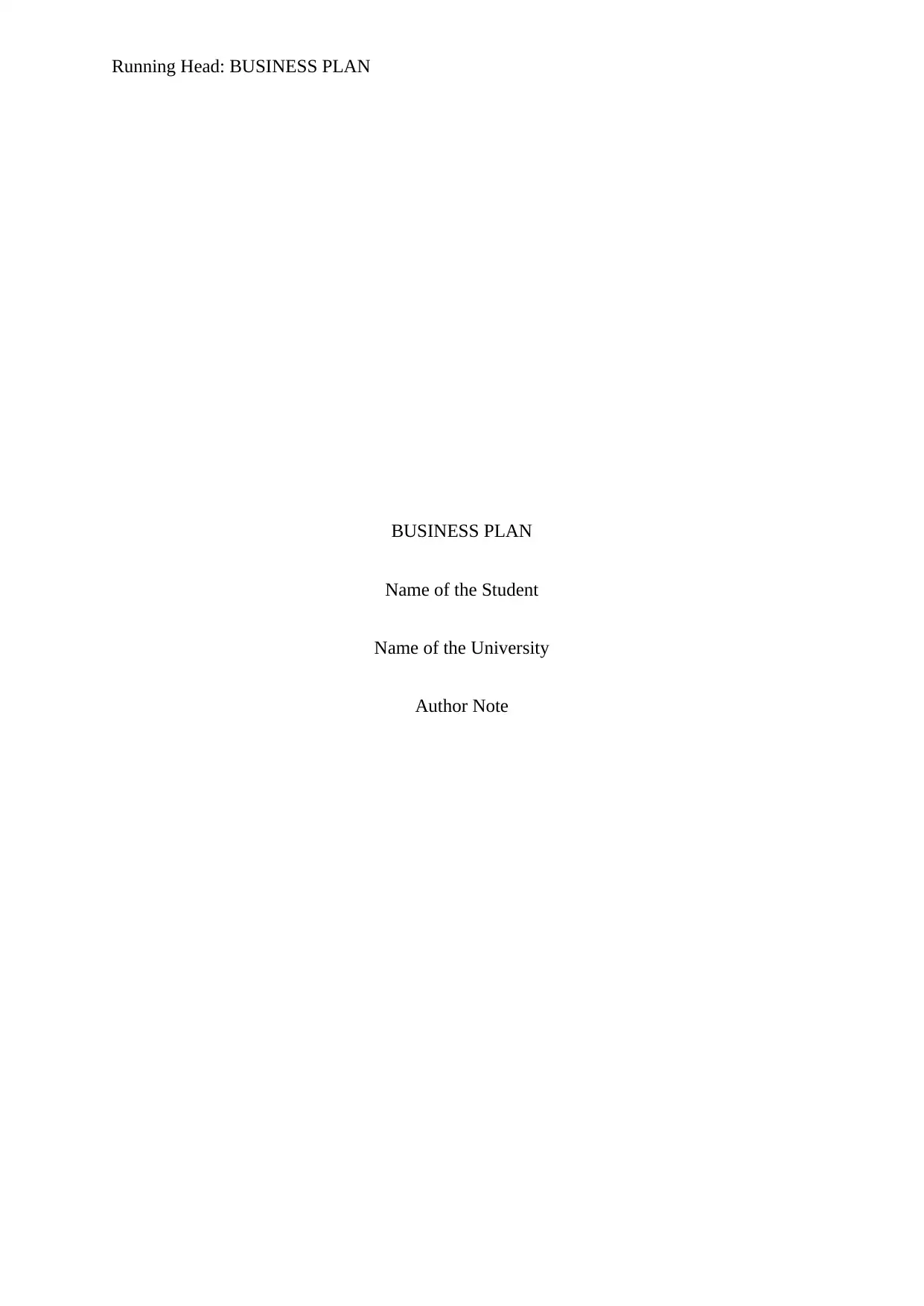
Running Head: BUSINESS PLAN
BUSINESS PLAN
Name of the Student
Name of the University
Author Note
BUSINESS PLAN
Name of the Student
Name of the University
Author Note
Paraphrase This Document
Need a fresh take? Get an instant paraphrase of this document with our AI Paraphraser
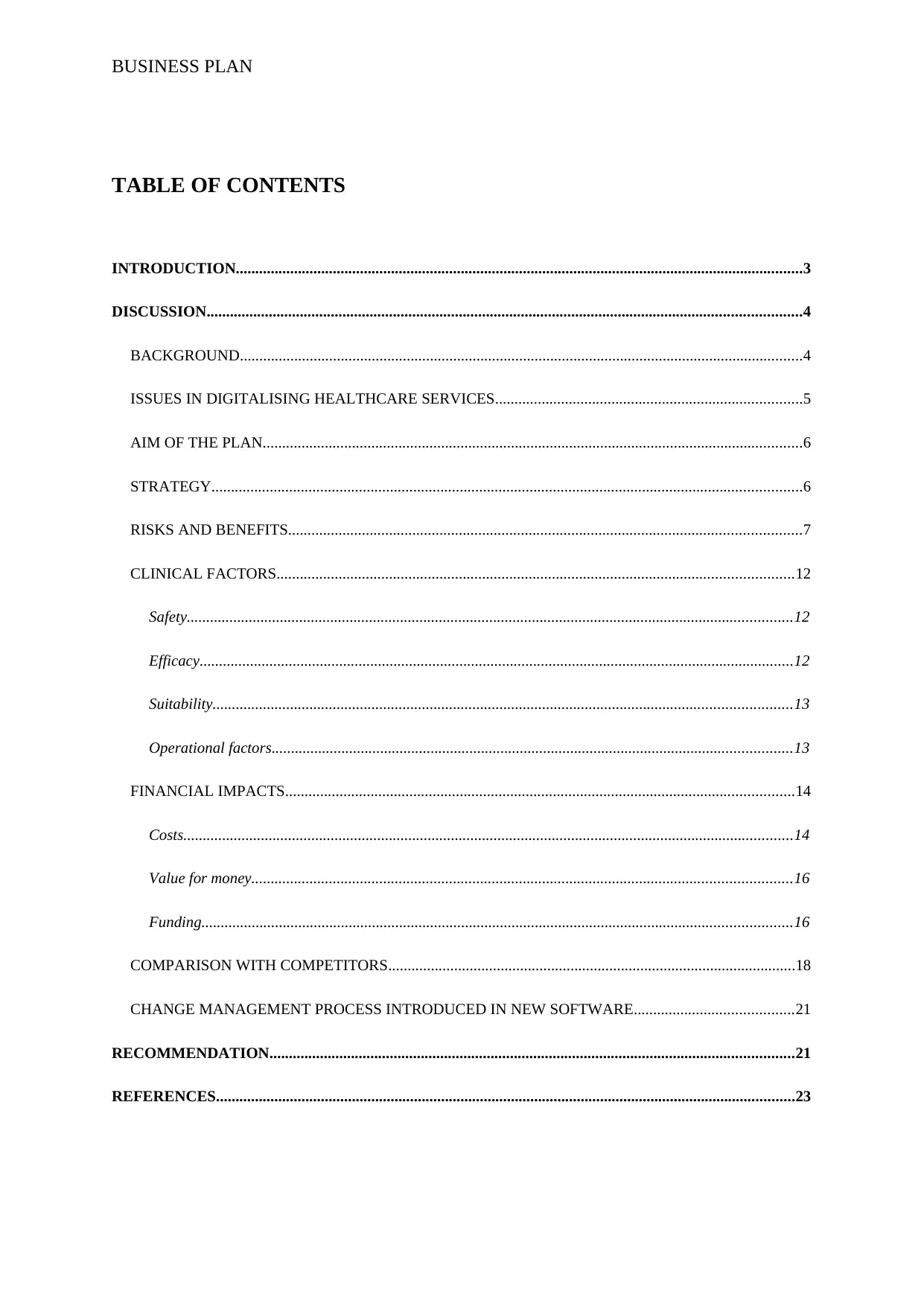
BUSINESS PLAN
TABLE OF CONTENTS
INTRODUCTION..................................................................................................................................................3
DISCUSSION.........................................................................................................................................................4
BACKGROUND.................................................................................................................................................4
ISSUES IN DIGITALISING HEALTHCARE SERVICES...............................................................................5
AIM OF THE PLAN...........................................................................................................................................6
STRATEGY........................................................................................................................................................6
RISKS AND BENEFITS....................................................................................................................................7
CLINICAL FACTORS.....................................................................................................................................12
Safety............................................................................................................................................................12
Efficacy.........................................................................................................................................................12
Suitability.....................................................................................................................................................13
Operational factors......................................................................................................................................13
FINANCIAL IMPACTS...................................................................................................................................14
Costs.............................................................................................................................................................14
Value for money...........................................................................................................................................16
Funding........................................................................................................................................................16
COMPARISON WITH COMPETITORS.........................................................................................................18
CHANGE MANAGEMENT PROCESS INTRODUCED IN NEW SOFTWARE.........................................21
RECOMMENDATION.......................................................................................................................................21
REFERENCES.....................................................................................................................................................23
TABLE OF CONTENTS
INTRODUCTION..................................................................................................................................................3
DISCUSSION.........................................................................................................................................................4
BACKGROUND.................................................................................................................................................4
ISSUES IN DIGITALISING HEALTHCARE SERVICES...............................................................................5
AIM OF THE PLAN...........................................................................................................................................6
STRATEGY........................................................................................................................................................6
RISKS AND BENEFITS....................................................................................................................................7
CLINICAL FACTORS.....................................................................................................................................12
Safety............................................................................................................................................................12
Efficacy.........................................................................................................................................................12
Suitability.....................................................................................................................................................13
Operational factors......................................................................................................................................13
FINANCIAL IMPACTS...................................................................................................................................14
Costs.............................................................................................................................................................14
Value for money...........................................................................................................................................16
Funding........................................................................................................................................................16
COMPARISON WITH COMPETITORS.........................................................................................................18
CHANGE MANAGEMENT PROCESS INTRODUCED IN NEW SOFTWARE.........................................21
RECOMMENDATION.......................................................................................................................................21
REFERENCES.....................................................................................................................................................23
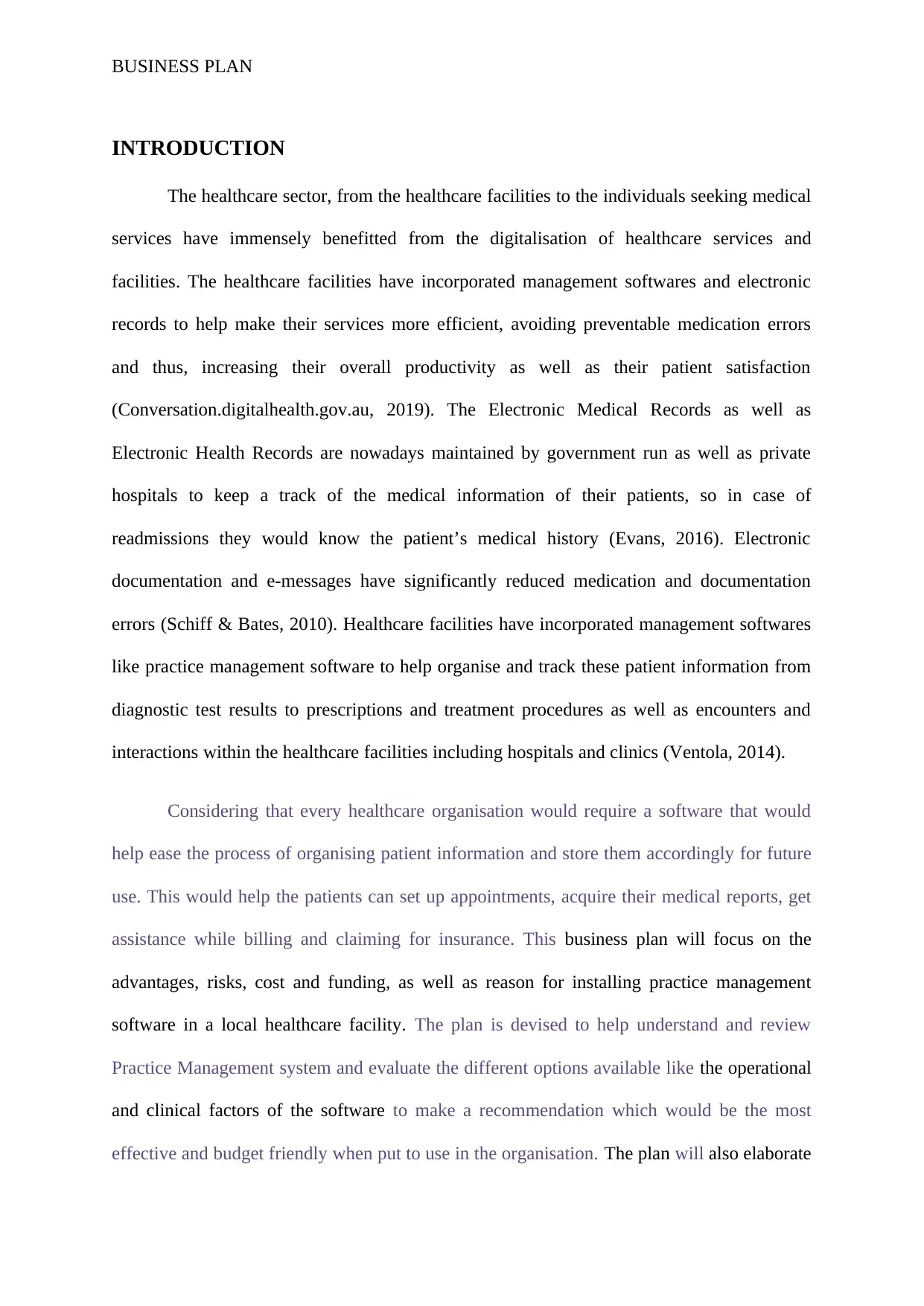
BUSINESS PLAN
INTRODUCTION
The healthcare sector, from the healthcare facilities to the individuals seeking medical
services have immensely benefitted from the digitalisation of healthcare services and
facilities. The healthcare facilities have incorporated management softwares and electronic
records to help make their services more efficient, avoiding preventable medication errors
and thus, increasing their overall productivity as well as their patient satisfaction
(Conversation.digitalhealth.gov.au, 2019). The Electronic Medical Records as well as
Electronic Health Records are nowadays maintained by government run as well as private
hospitals to keep a track of the medical information of their patients, so in case of
readmissions they would know the patient’s medical history (Evans, 2016). Electronic
documentation and e-messages have significantly reduced medication and documentation
errors (Schiff & Bates, 2010). Healthcare facilities have incorporated management softwares
like practice management software to help organise and track these patient information from
diagnostic test results to prescriptions and treatment procedures as well as encounters and
interactions within the healthcare facilities including hospitals and clinics (Ventola, 2014).
Considering that every healthcare organisation would require a software that would
help ease the process of organising patient information and store them accordingly for future
use. This would help the patients can set up appointments, acquire their medical reports, get
assistance while billing and claiming for insurance. This business plan will focus on the
advantages, risks, cost and funding, as well as reason for installing practice management
software in a local healthcare facility. The plan is devised to help understand and review
Practice Management system and evaluate the different options available like the operational
and clinical factors of the software to make a recommendation which would be the most
effective and budget friendly when put to use in the organisation. The plan will also elaborate
INTRODUCTION
The healthcare sector, from the healthcare facilities to the individuals seeking medical
services have immensely benefitted from the digitalisation of healthcare services and
facilities. The healthcare facilities have incorporated management softwares and electronic
records to help make their services more efficient, avoiding preventable medication errors
and thus, increasing their overall productivity as well as their patient satisfaction
(Conversation.digitalhealth.gov.au, 2019). The Electronic Medical Records as well as
Electronic Health Records are nowadays maintained by government run as well as private
hospitals to keep a track of the medical information of their patients, so in case of
readmissions they would know the patient’s medical history (Evans, 2016). Electronic
documentation and e-messages have significantly reduced medication and documentation
errors (Schiff & Bates, 2010). Healthcare facilities have incorporated management softwares
like practice management software to help organise and track these patient information from
diagnostic test results to prescriptions and treatment procedures as well as encounters and
interactions within the healthcare facilities including hospitals and clinics (Ventola, 2014).
Considering that every healthcare organisation would require a software that would
help ease the process of organising patient information and store them accordingly for future
use. This would help the patients can set up appointments, acquire their medical reports, get
assistance while billing and claiming for insurance. This business plan will focus on the
advantages, risks, cost and funding, as well as reason for installing practice management
software in a local healthcare facility. The plan is devised to help understand and review
Practice Management system and evaluate the different options available like the operational
and clinical factors of the software to make a recommendation which would be the most
effective and budget friendly when put to use in the organisation. The plan will also elaborate
⊘ This is a preview!⊘
Do you want full access?
Subscribe today to unlock all pages.

Trusted by 1+ million students worldwide
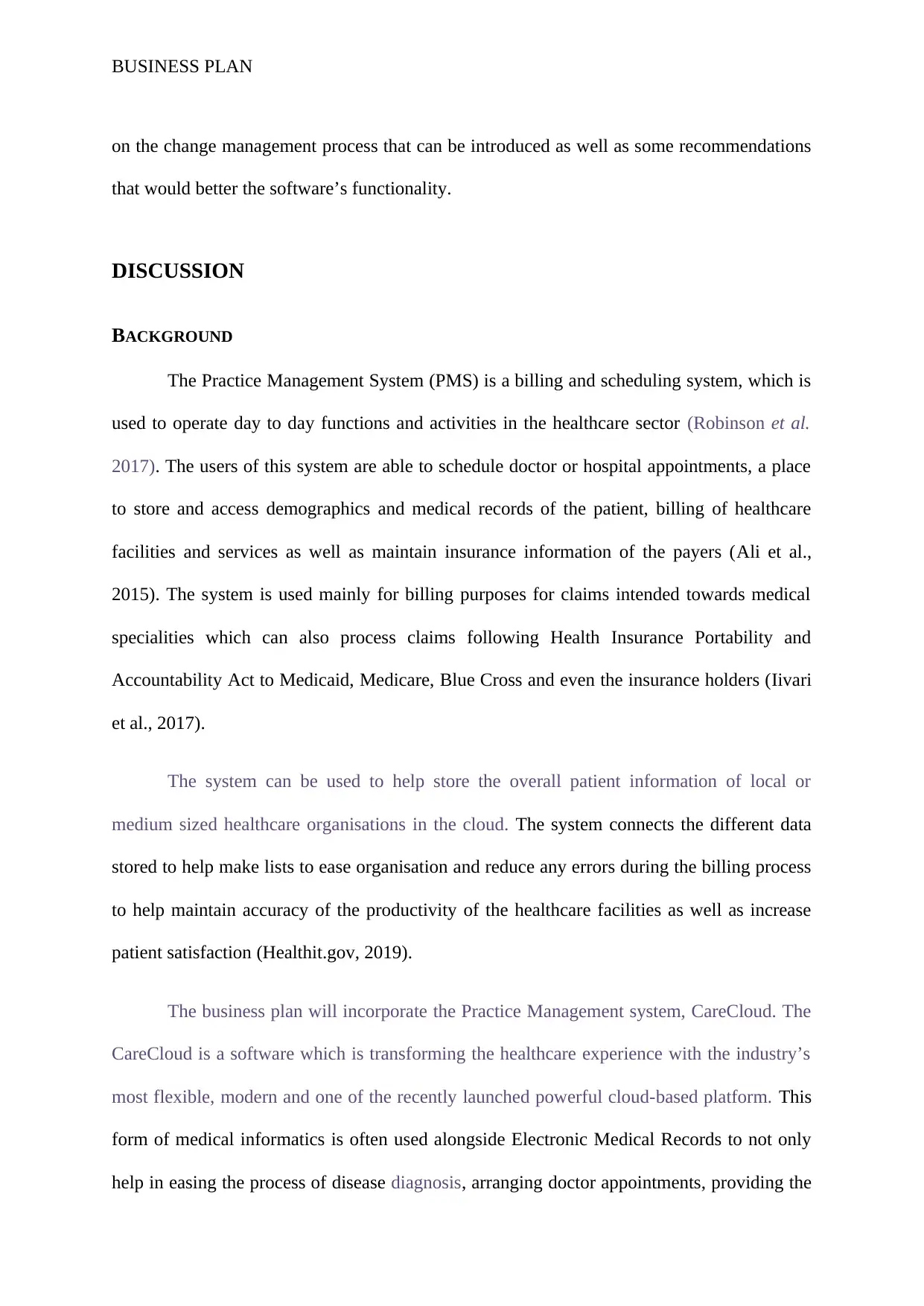
BUSINESS PLAN
on the change management process that can be introduced as well as some recommendations
that would better the software’s functionality.
DISCUSSION
BACKGROUND
The Practice Management System (PMS) is a billing and scheduling system, which is
used to operate day to day functions and activities in the healthcare sector (Robinson et al.
2017). The users of this system are able to schedule doctor or hospital appointments, a place
to store and access demographics and medical records of the patient, billing of healthcare
facilities and services as well as maintain insurance information of the payers (Ali et al.,
2015). The system is used mainly for billing purposes for claims intended towards medical
specialities which can also process claims following Health Insurance Portability and
Accountability Act to Medicaid, Medicare, Blue Cross and even the insurance holders (Iivari
et al., 2017).
The system can be used to help store the overall patient information of local or
medium sized healthcare organisations in the cloud. The system connects the different data
stored to help make lists to ease organisation and reduce any errors during the billing process
to help maintain accuracy of the productivity of the healthcare facilities as well as increase
patient satisfaction (Healthit.gov, 2019).
The business plan will incorporate the Practice Management system, CareCloud. The
CareCloud is a software which is transforming the healthcare experience with the industry’s
most flexible, modern and one of the recently launched powerful cloud-based platform. This
form of medical informatics is often used alongside Electronic Medical Records to not only
help in easing the process of disease diagnosis, arranging doctor appointments, providing the
on the change management process that can be introduced as well as some recommendations
that would better the software’s functionality.
DISCUSSION
BACKGROUND
The Practice Management System (PMS) is a billing and scheduling system, which is
used to operate day to day functions and activities in the healthcare sector (Robinson et al.
2017). The users of this system are able to schedule doctor or hospital appointments, a place
to store and access demographics and medical records of the patient, billing of healthcare
facilities and services as well as maintain insurance information of the payers (Ali et al.,
2015). The system is used mainly for billing purposes for claims intended towards medical
specialities which can also process claims following Health Insurance Portability and
Accountability Act to Medicaid, Medicare, Blue Cross and even the insurance holders (Iivari
et al., 2017).
The system can be used to help store the overall patient information of local or
medium sized healthcare organisations in the cloud. The system connects the different data
stored to help make lists to ease organisation and reduce any errors during the billing process
to help maintain accuracy of the productivity of the healthcare facilities as well as increase
patient satisfaction (Healthit.gov, 2019).
The business plan will incorporate the Practice Management system, CareCloud. The
CareCloud is a software which is transforming the healthcare experience with the industry’s
most flexible, modern and one of the recently launched powerful cloud-based platform. This
form of medical informatics is often used alongside Electronic Medical Records to not only
help in easing the process of disease diagnosis, arranging doctor appointments, providing the
Paraphrase This Document
Need a fresh take? Get an instant paraphrase of this document with our AI Paraphraser
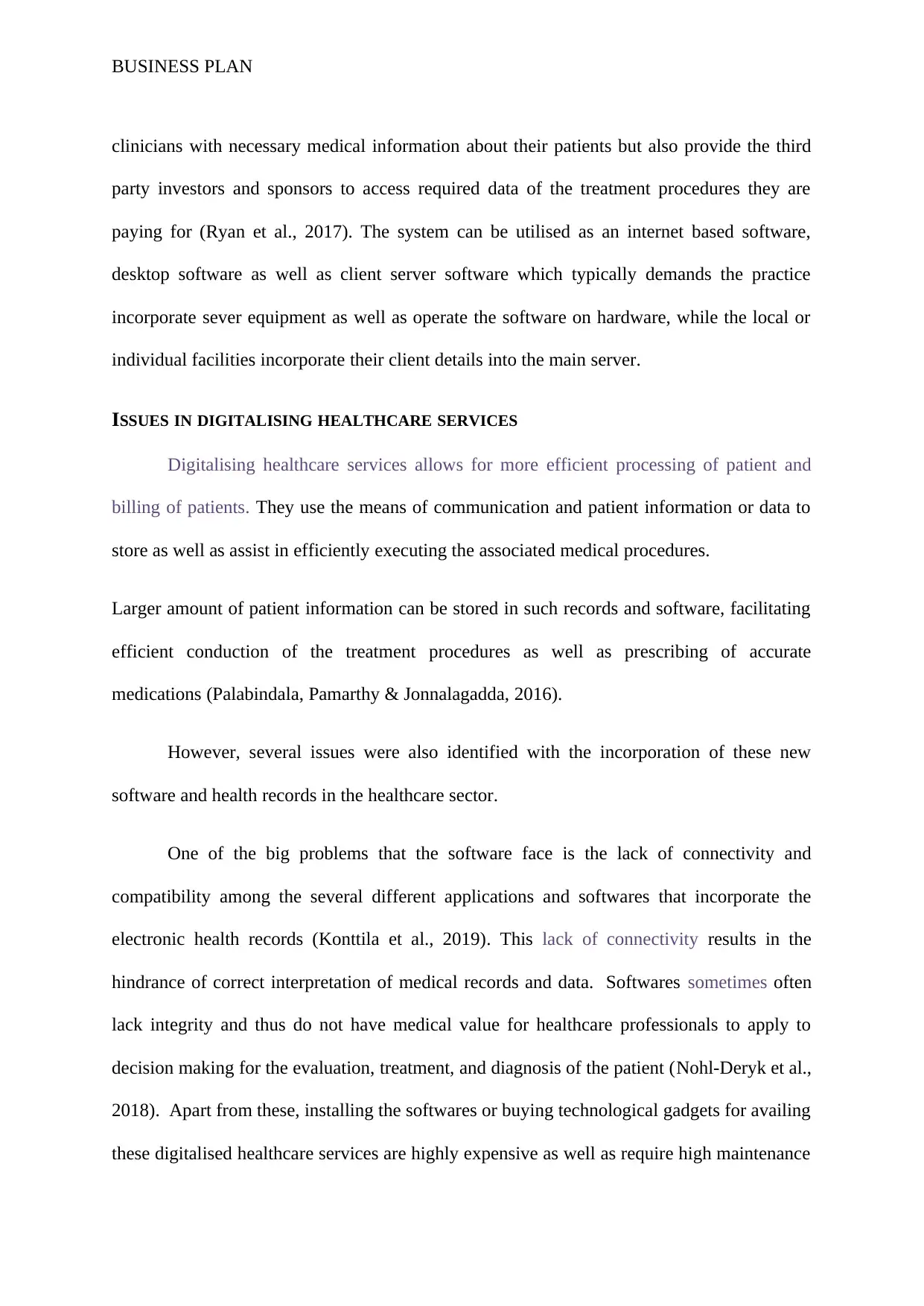
BUSINESS PLAN
clinicians with necessary medical information about their patients but also provide the third
party investors and sponsors to access required data of the treatment procedures they are
paying for (Ryan et al., 2017). The system can be utilised as an internet based software,
desktop software as well as client server software which typically demands the practice
incorporate sever equipment as well as operate the software on hardware, while the local or
individual facilities incorporate their client details into the main server.
ISSUES IN DIGITALISING HEALTHCARE SERVICES
Digitalising healthcare services allows for more efficient processing of patient and
billing of patients. They use the means of communication and patient information or data to
store as well as assist in efficiently executing the associated medical procedures.
Larger amount of patient information can be stored in such records and software, facilitating
efficient conduction of the treatment procedures as well as prescribing of accurate
medications (Palabindala, Pamarthy & Jonnalagadda, 2016).
However, several issues were also identified with the incorporation of these new
software and health records in the healthcare sector.
One of the big problems that the software face is the lack of connectivity and
compatibility among the several different applications and softwares that incorporate the
electronic health records (Konttila et al., 2019). This lack of connectivity results in the
hindrance of correct interpretation of medical records and data. Softwares sometimes often
lack integrity and thus do not have medical value for healthcare professionals to apply to
decision making for the evaluation, treatment, and diagnosis of the patient (Nohl-Deryk et al.,
2018). Apart from these, installing the softwares or buying technological gadgets for availing
these digitalised healthcare services are highly expensive as well as require high maintenance
clinicians with necessary medical information about their patients but also provide the third
party investors and sponsors to access required data of the treatment procedures they are
paying for (Ryan et al., 2017). The system can be utilised as an internet based software,
desktop software as well as client server software which typically demands the practice
incorporate sever equipment as well as operate the software on hardware, while the local or
individual facilities incorporate their client details into the main server.
ISSUES IN DIGITALISING HEALTHCARE SERVICES
Digitalising healthcare services allows for more efficient processing of patient and
billing of patients. They use the means of communication and patient information or data to
store as well as assist in efficiently executing the associated medical procedures.
Larger amount of patient information can be stored in such records and software, facilitating
efficient conduction of the treatment procedures as well as prescribing of accurate
medications (Palabindala, Pamarthy & Jonnalagadda, 2016).
However, several issues were also identified with the incorporation of these new
software and health records in the healthcare sector.
One of the big problems that the software face is the lack of connectivity and
compatibility among the several different applications and softwares that incorporate the
electronic health records (Konttila et al., 2019). This lack of connectivity results in the
hindrance of correct interpretation of medical records and data. Softwares sometimes often
lack integrity and thus do not have medical value for healthcare professionals to apply to
decision making for the evaluation, treatment, and diagnosis of the patient (Nohl-Deryk et al.,
2018). Apart from these, installing the softwares or buying technological gadgets for availing
these digitalised healthcare services are highly expensive as well as require high maintenance
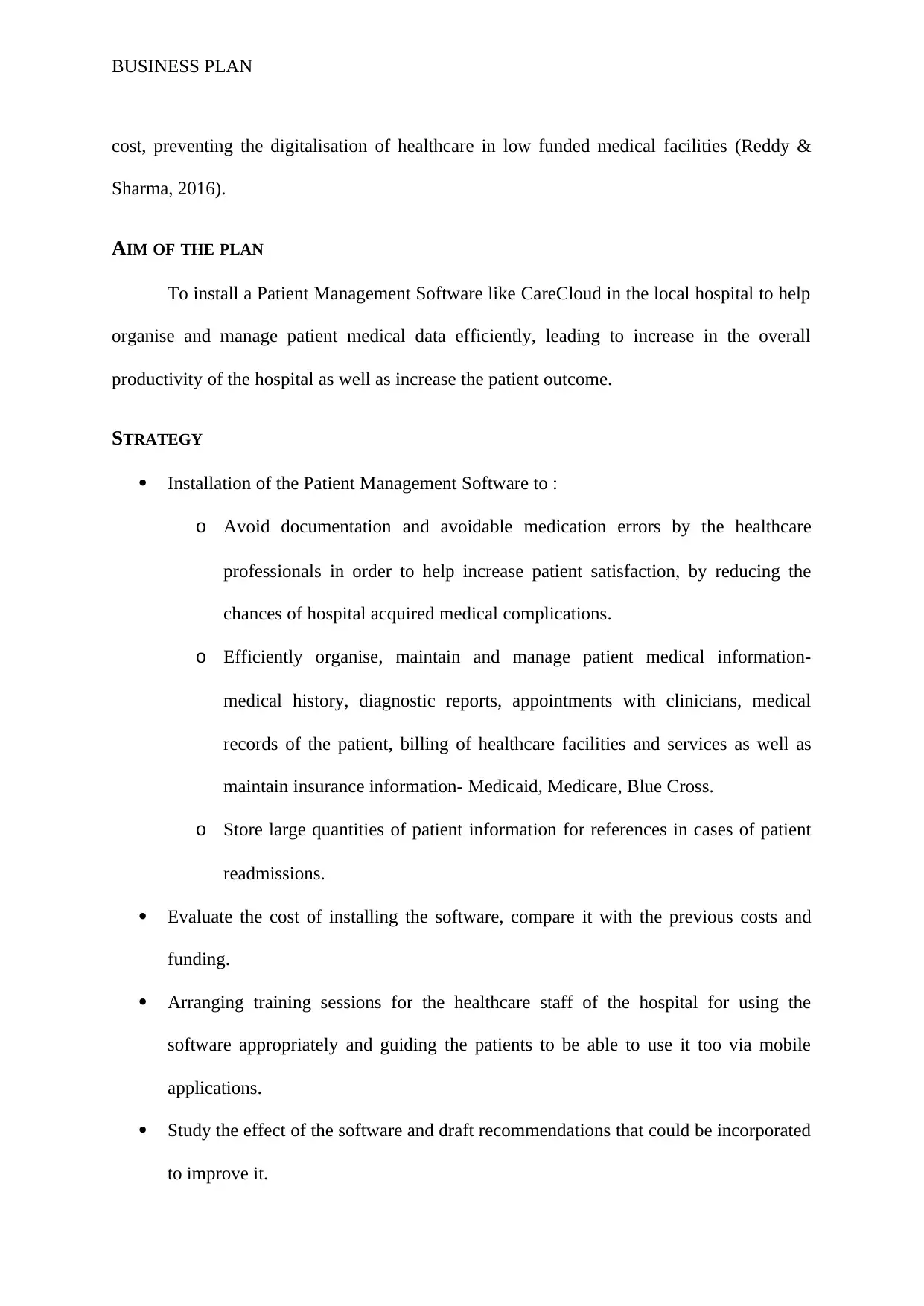
BUSINESS PLAN
cost, preventing the digitalisation of healthcare in low funded medical facilities (Reddy &
Sharma, 2016).
AIM OF THE PLAN
To install a Patient Management Software like CareCloud in the local hospital to help
organise and manage patient medical data efficiently, leading to increase in the overall
productivity of the hospital as well as increase the patient outcome.
STRATEGY
Installation of the Patient Management Software to :
o Avoid documentation and avoidable medication errors by the healthcare
professionals in order to help increase patient satisfaction, by reducing the
chances of hospital acquired medical complications.
o Efficiently organise, maintain and manage patient medical information-
medical history, diagnostic reports, appointments with clinicians, medical
records of the patient, billing of healthcare facilities and services as well as
maintain insurance information- Medicaid, Medicare, Blue Cross.
o Store large quantities of patient information for references in cases of patient
readmissions.
Evaluate the cost of installing the software, compare it with the previous costs and
funding.
Arranging training sessions for the healthcare staff of the hospital for using the
software appropriately and guiding the patients to be able to use it too via mobile
applications.
Study the effect of the software and draft recommendations that could be incorporated
to improve it.
cost, preventing the digitalisation of healthcare in low funded medical facilities (Reddy &
Sharma, 2016).
AIM OF THE PLAN
To install a Patient Management Software like CareCloud in the local hospital to help
organise and manage patient medical data efficiently, leading to increase in the overall
productivity of the hospital as well as increase the patient outcome.
STRATEGY
Installation of the Patient Management Software to :
o Avoid documentation and avoidable medication errors by the healthcare
professionals in order to help increase patient satisfaction, by reducing the
chances of hospital acquired medical complications.
o Efficiently organise, maintain and manage patient medical information-
medical history, diagnostic reports, appointments with clinicians, medical
records of the patient, billing of healthcare facilities and services as well as
maintain insurance information- Medicaid, Medicare, Blue Cross.
o Store large quantities of patient information for references in cases of patient
readmissions.
Evaluate the cost of installing the software, compare it with the previous costs and
funding.
Arranging training sessions for the healthcare staff of the hospital for using the
software appropriately and guiding the patients to be able to use it too via mobile
applications.
Study the effect of the software and draft recommendations that could be incorporated
to improve it.
⊘ This is a preview!⊘
Do you want full access?
Subscribe today to unlock all pages.

Trusted by 1+ million students worldwide
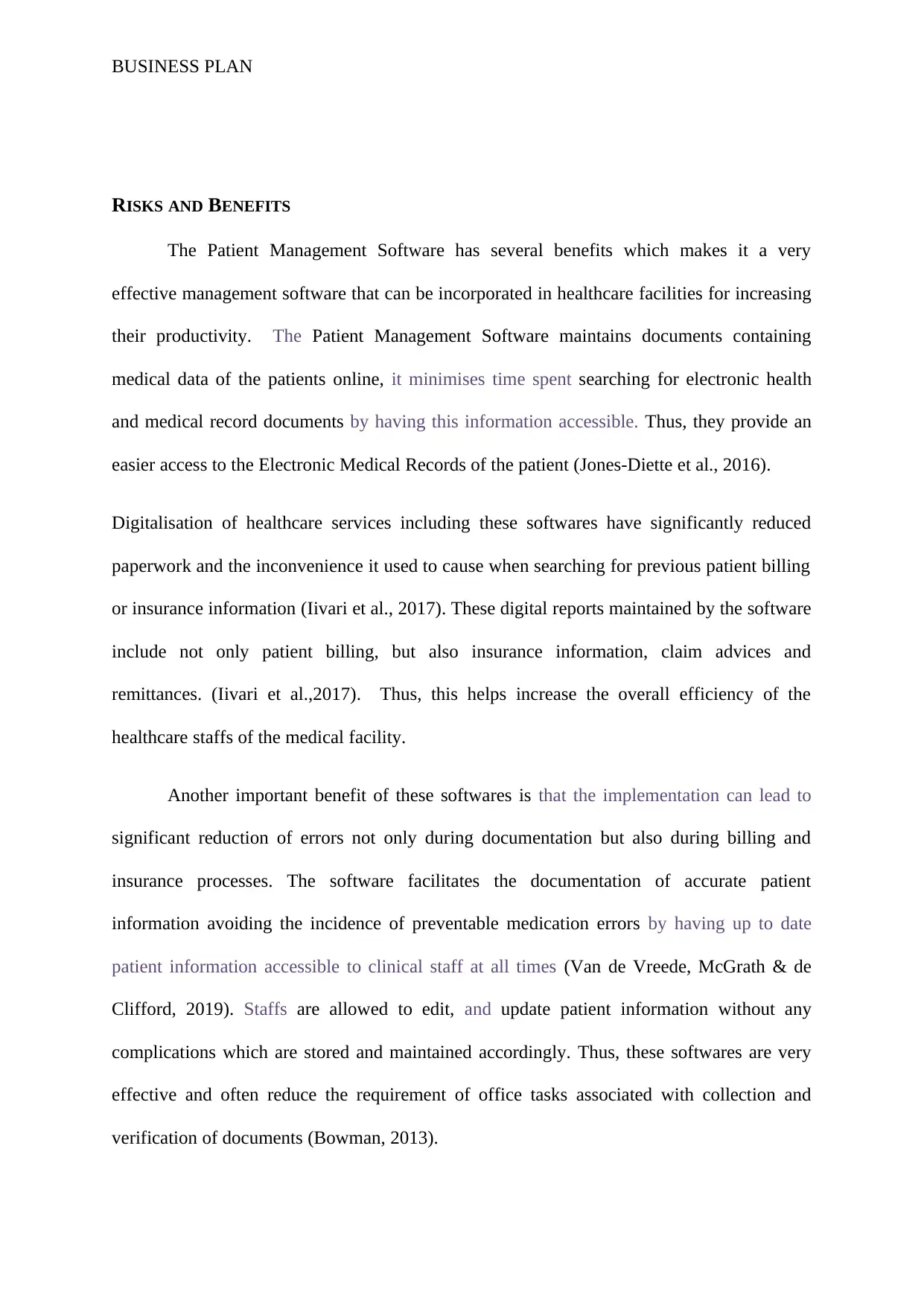
BUSINESS PLAN
RISKS AND BENEFITS
The Patient Management Software has several benefits which makes it a very
effective management software that can be incorporated in healthcare facilities for increasing
their productivity. The Patient Management Software maintains documents containing
medical data of the patients online, it minimises time spent searching for electronic health
and medical record documents by having this information accessible. Thus, they provide an
easier access to the Electronic Medical Records of the patient (Jones-Diette et al., 2016).
Digitalisation of healthcare services including these softwares have significantly reduced
paperwork and the inconvenience it used to cause when searching for previous patient billing
or insurance information (Iivari et al., 2017). These digital reports maintained by the software
include not only patient billing, but also insurance information, claim advices and
remittances. (Iivari et al.,2017). Thus, this helps increase the overall efficiency of the
healthcare staffs of the medical facility.
Another important benefit of these softwares is that the implementation can lead to
significant reduction of errors not only during documentation but also during billing and
insurance processes. The software facilitates the documentation of accurate patient
information avoiding the incidence of preventable medication errors by having up to date
patient information accessible to clinical staff at all times (Van de Vreede, McGrath & de
Clifford, 2019). Staffs are allowed to edit, and update patient information without any
complications which are stored and maintained accordingly. Thus, these softwares are very
effective and often reduce the requirement of office tasks associated with collection and
verification of documents (Bowman, 2013).
RISKS AND BENEFITS
The Patient Management Software has several benefits which makes it a very
effective management software that can be incorporated in healthcare facilities for increasing
their productivity. The Patient Management Software maintains documents containing
medical data of the patients online, it minimises time spent searching for electronic health
and medical record documents by having this information accessible. Thus, they provide an
easier access to the Electronic Medical Records of the patient (Jones-Diette et al., 2016).
Digitalisation of healthcare services including these softwares have significantly reduced
paperwork and the inconvenience it used to cause when searching for previous patient billing
or insurance information (Iivari et al., 2017). These digital reports maintained by the software
include not only patient billing, but also insurance information, claim advices and
remittances. (Iivari et al.,2017). Thus, this helps increase the overall efficiency of the
healthcare staffs of the medical facility.
Another important benefit of these softwares is that the implementation can lead to
significant reduction of errors not only during documentation but also during billing and
insurance processes. The software facilitates the documentation of accurate patient
information avoiding the incidence of preventable medication errors by having up to date
patient information accessible to clinical staff at all times (Van de Vreede, McGrath & de
Clifford, 2019). Staffs are allowed to edit, and update patient information without any
complications which are stored and maintained accordingly. Thus, these softwares are very
effective and often reduce the requirement of office tasks associated with collection and
verification of documents (Bowman, 2013).
Paraphrase This Document
Need a fresh take? Get an instant paraphrase of this document with our AI Paraphraser
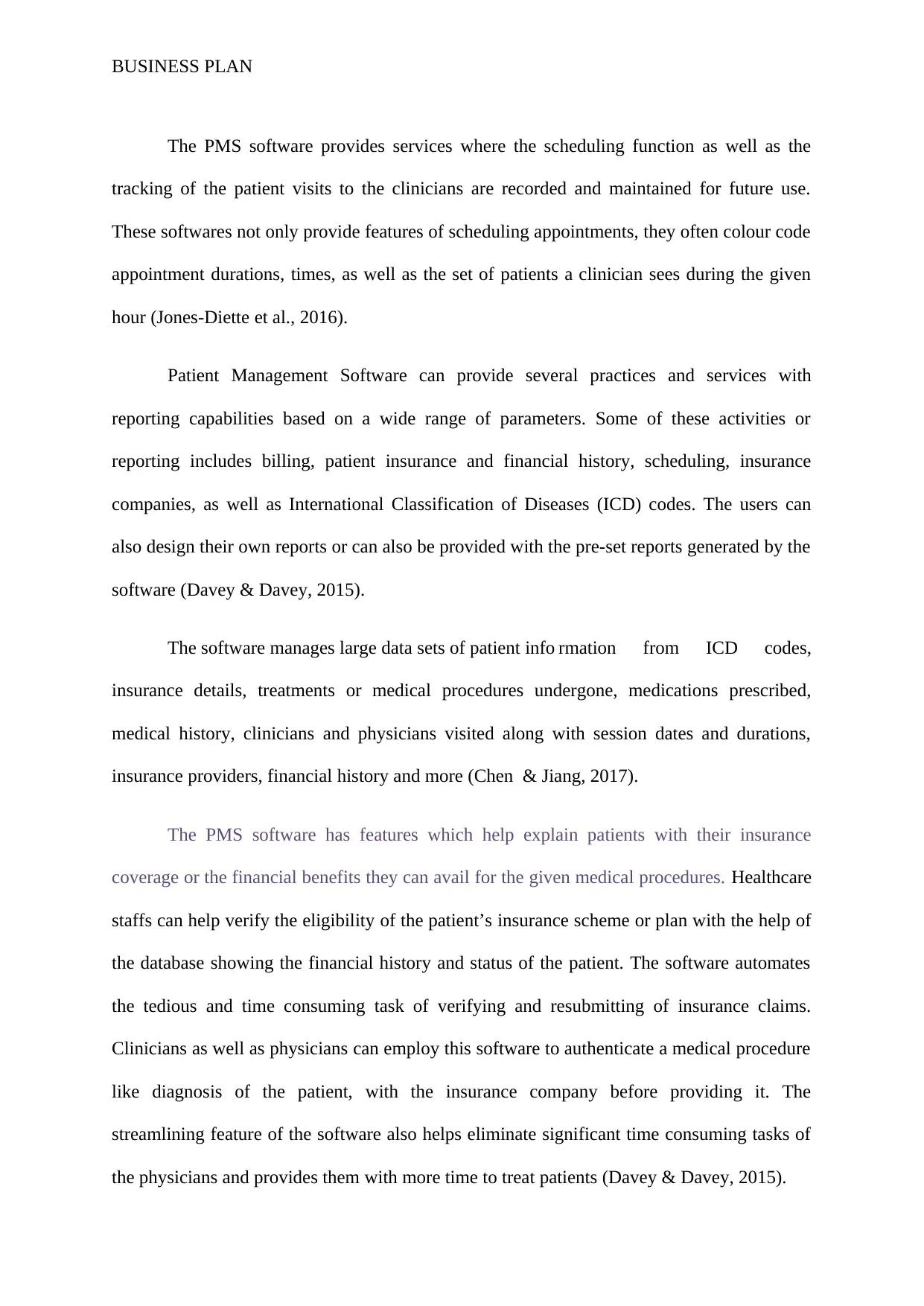
BUSINESS PLAN
The PMS software provides services where the scheduling function as well as the
tracking of the patient visits to the clinicians are recorded and maintained for future use.
These softwares not only provide features of scheduling appointments, they often colour code
appointment durations, times, as well as the set of patients a clinician sees during the given
hour (Jones-Diette et al., 2016).
Patient Management Software can provide several practices and services with
reporting capabilities based on a wide range of parameters. Some of these activities or
reporting includes billing, patient insurance and financial history, scheduling, insurance
companies, as well as International Classification of Diseases (ICD) codes. The users can
also design their own reports or can also be provided with the pre-set reports generated by the
software (Davey & Davey, 2015).
The software manages large data sets of patient info rmation from ICD codes,
insurance details, treatments or medical procedures undergone, medications prescribed,
medical history, clinicians and physicians visited along with session dates and durations,
insurance providers, financial history and more (Chen & Jiang, 2017).
The PMS software has features which help explain patients with their insurance
coverage or the financial benefits they can avail for the given medical procedures. Healthcare
staffs can help verify the eligibility of the patient’s insurance scheme or plan with the help of
the database showing the financial history and status of the patient. The software automates
the tedious and time consuming task of verifying and resubmitting of insurance claims.
Clinicians as well as physicians can employ this software to authenticate a medical procedure
like diagnosis of the patient, with the insurance company before providing it. The
streamlining feature of the software also helps eliminate significant time consuming tasks of
the physicians and provides them with more time to treat patients (Davey & Davey, 2015).
The PMS software provides services where the scheduling function as well as the
tracking of the patient visits to the clinicians are recorded and maintained for future use.
These softwares not only provide features of scheduling appointments, they often colour code
appointment durations, times, as well as the set of patients a clinician sees during the given
hour (Jones-Diette et al., 2016).
Patient Management Software can provide several practices and services with
reporting capabilities based on a wide range of parameters. Some of these activities or
reporting includes billing, patient insurance and financial history, scheduling, insurance
companies, as well as International Classification of Diseases (ICD) codes. The users can
also design their own reports or can also be provided with the pre-set reports generated by the
software (Davey & Davey, 2015).
The software manages large data sets of patient info rmation from ICD codes,
insurance details, treatments or medical procedures undergone, medications prescribed,
medical history, clinicians and physicians visited along with session dates and durations,
insurance providers, financial history and more (Chen & Jiang, 2017).
The PMS software has features which help explain patients with their insurance
coverage or the financial benefits they can avail for the given medical procedures. Healthcare
staffs can help verify the eligibility of the patient’s insurance scheme or plan with the help of
the database showing the financial history and status of the patient. The software automates
the tedious and time consuming task of verifying and resubmitting of insurance claims.
Clinicians as well as physicians can employ this software to authenticate a medical procedure
like diagnosis of the patient, with the insurance company before providing it. The
streamlining feature of the software also helps eliminate significant time consuming tasks of
the physicians and provides them with more time to treat patients (Davey & Davey, 2015).
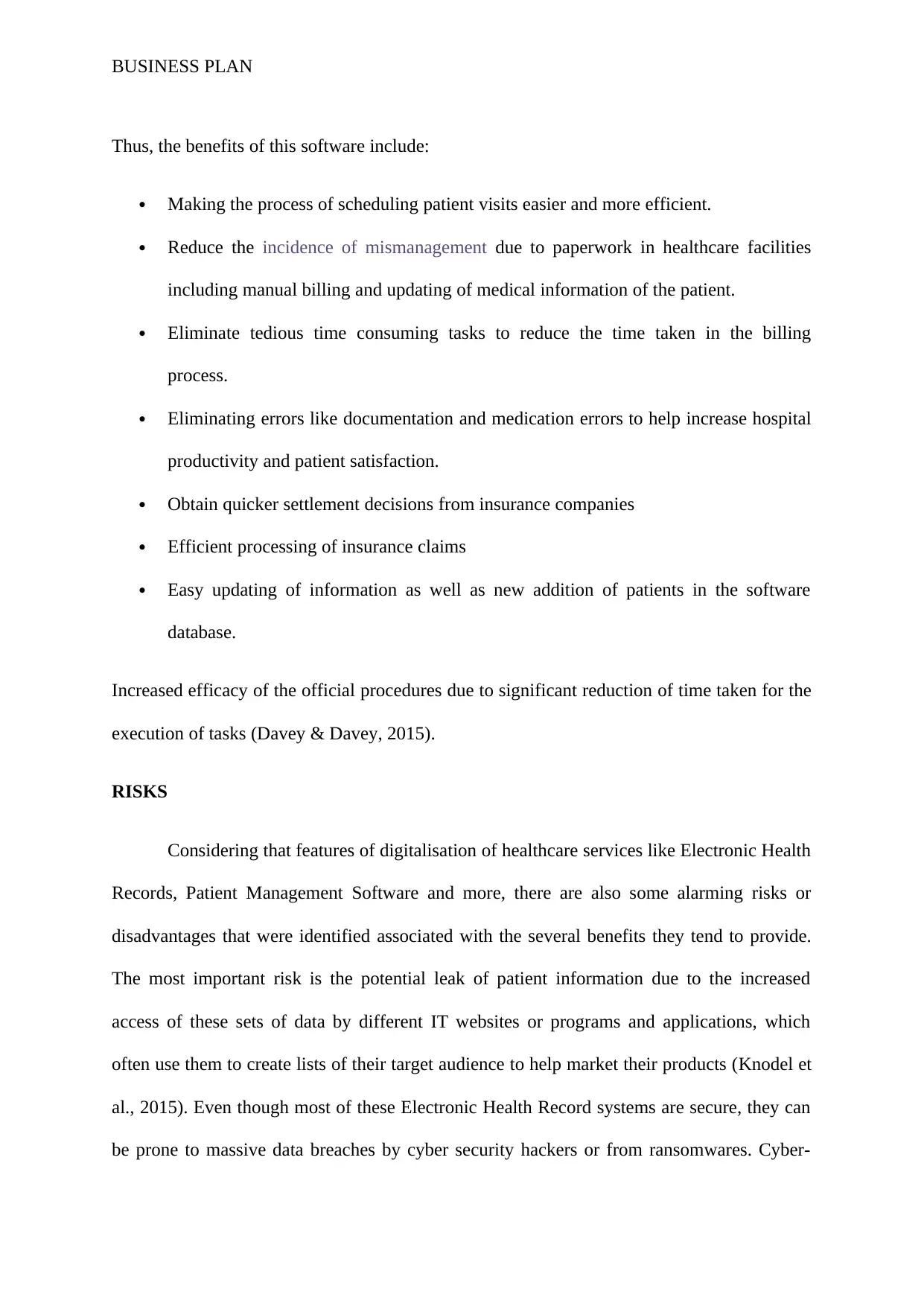
BUSINESS PLAN
Thus, the benefits of this software include:
Making the process of scheduling patient visits easier and more efficient.
Reduce the incidence of mismanagement due to paperwork in healthcare facilities
including manual billing and updating of medical information of the patient.
Eliminate tedious time consuming tasks to reduce the time taken in the billing
process.
Eliminating errors like documentation and medication errors to help increase hospital
productivity and patient satisfaction.
Obtain quicker settlement decisions from insurance companies
Efficient processing of insurance claims
Easy updating of information as well as new addition of patients in the software
database.
Increased efficacy of the official procedures due to significant reduction of time taken for the
execution of tasks (Davey & Davey, 2015).
RISKS
Considering that features of digitalisation of healthcare services like Electronic Health
Records, Patient Management Software and more, there are also some alarming risks or
disadvantages that were identified associated with the several benefits they tend to provide.
The most important risk is the potential leak of patient information due to the increased
access of these sets of data by different IT websites or programs and applications, which
often use them to create lists of their target audience to help market their products (Knodel et
al., 2015). Even though most of these Electronic Health Record systems are secure, they can
be prone to massive data breaches by cyber security hackers or from ransomwares. Cyber-
Thus, the benefits of this software include:
Making the process of scheduling patient visits easier and more efficient.
Reduce the incidence of mismanagement due to paperwork in healthcare facilities
including manual billing and updating of medical information of the patient.
Eliminate tedious time consuming tasks to reduce the time taken in the billing
process.
Eliminating errors like documentation and medication errors to help increase hospital
productivity and patient satisfaction.
Obtain quicker settlement decisions from insurance companies
Efficient processing of insurance claims
Easy updating of information as well as new addition of patients in the software
database.
Increased efficacy of the official procedures due to significant reduction of time taken for the
execution of tasks (Davey & Davey, 2015).
RISKS
Considering that features of digitalisation of healthcare services like Electronic Health
Records, Patient Management Software and more, there are also some alarming risks or
disadvantages that were identified associated with the several benefits they tend to provide.
The most important risk is the potential leak of patient information due to the increased
access of these sets of data by different IT websites or programs and applications, which
often use them to create lists of their target audience to help market their products (Knodel et
al., 2015). Even though most of these Electronic Health Record systems are secure, they can
be prone to massive data breaches by cyber security hackers or from ransomwares. Cyber-
⊘ This is a preview!⊘
Do you want full access?
Subscribe today to unlock all pages.

Trusted by 1+ million students worldwide
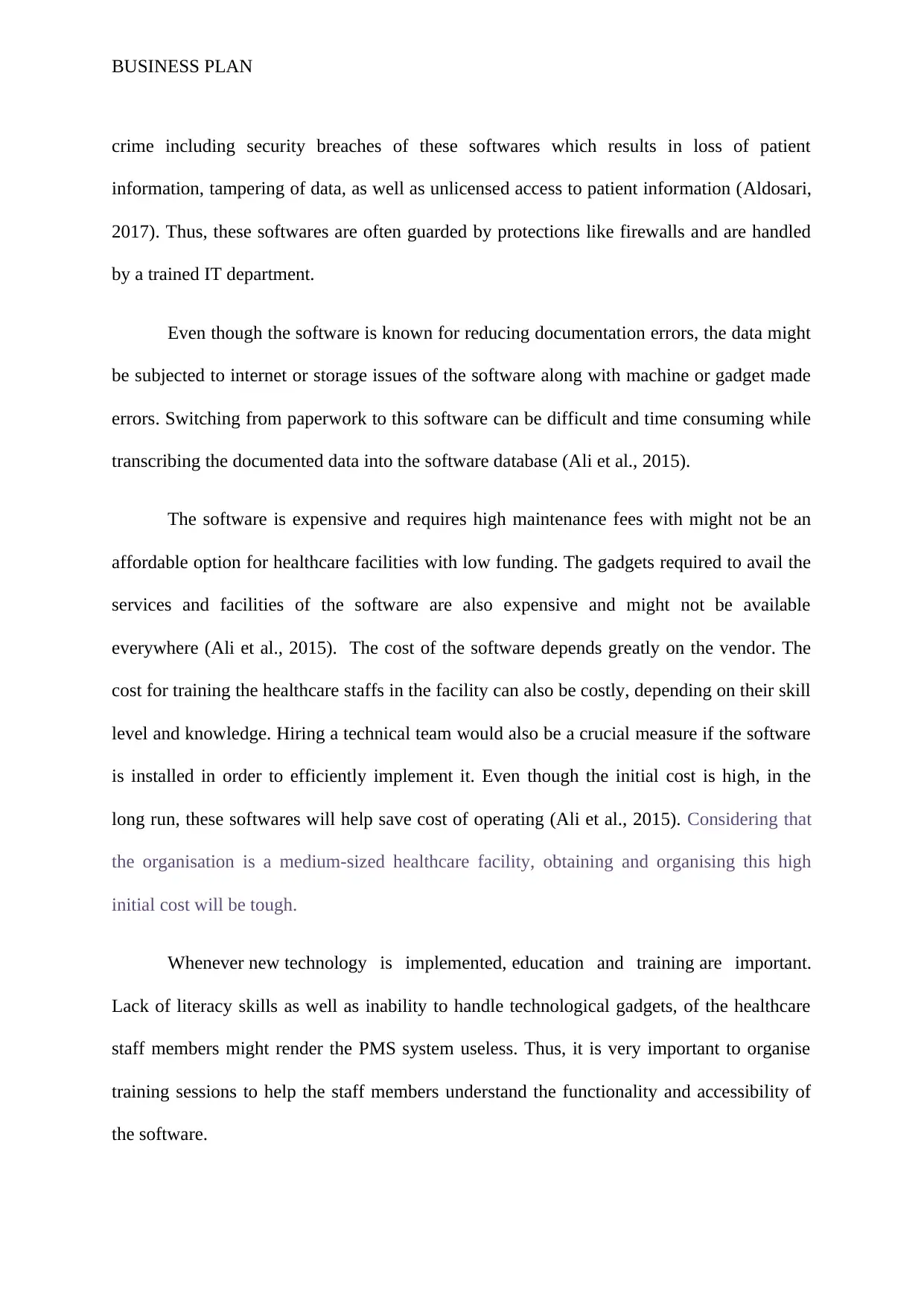
BUSINESS PLAN
crime including security breaches of these softwares which results in loss of patient
information, tampering of data, as well as unlicensed access to patient information (Aldosari,
2017). Thus, these softwares are often guarded by protections like firewalls and are handled
by a trained IT department.
Even though the software is known for reducing documentation errors, the data might
be subjected to internet or storage issues of the software along with machine or gadget made
errors. Switching from paperwork to this software can be difficult and time consuming while
transcribing the documented data into the software database (Ali et al., 2015).
The software is expensive and requires high maintenance fees with might not be an
affordable option for healthcare facilities with low funding. The gadgets required to avail the
services and facilities of the software are also expensive and might not be available
everywhere (Ali et al., 2015). The cost of the software depends greatly on the vendor. The
cost for training the healthcare staffs in the facility can also be costly, depending on their skill
level and knowledge. Hiring a technical team would also be a crucial measure if the software
is installed in order to efficiently implement it. Even though the initial cost is high, in the
long run, these softwares will help save cost of operating (Ali et al., 2015). Considering that
the organisation is a medium-sized healthcare facility, obtaining and organising this high
initial cost will be tough.
Whenever new technology is implemented, education and training are important.
Lack of literacy skills as well as inability to handle technological gadgets, of the healthcare
staff members might render the PMS system useless. Thus, it is very important to organise
training sessions to help the staff members understand the functionality and accessibility of
the software.
crime including security breaches of these softwares which results in loss of patient
information, tampering of data, as well as unlicensed access to patient information (Aldosari,
2017). Thus, these softwares are often guarded by protections like firewalls and are handled
by a trained IT department.
Even though the software is known for reducing documentation errors, the data might
be subjected to internet or storage issues of the software along with machine or gadget made
errors. Switching from paperwork to this software can be difficult and time consuming while
transcribing the documented data into the software database (Ali et al., 2015).
The software is expensive and requires high maintenance fees with might not be an
affordable option for healthcare facilities with low funding. The gadgets required to avail the
services and facilities of the software are also expensive and might not be available
everywhere (Ali et al., 2015). The cost of the software depends greatly on the vendor. The
cost for training the healthcare staffs in the facility can also be costly, depending on their skill
level and knowledge. Hiring a technical team would also be a crucial measure if the software
is installed in order to efficiently implement it. Even though the initial cost is high, in the
long run, these softwares will help save cost of operating (Ali et al., 2015). Considering that
the organisation is a medium-sized healthcare facility, obtaining and organising this high
initial cost will be tough.
Whenever new technology is implemented, education and training are important.
Lack of literacy skills as well as inability to handle technological gadgets, of the healthcare
staff members might render the PMS system useless. Thus, it is very important to organise
training sessions to help the staff members understand the functionality and accessibility of
the software.
Paraphrase This Document
Need a fresh take? Get an instant paraphrase of this document with our AI Paraphraser
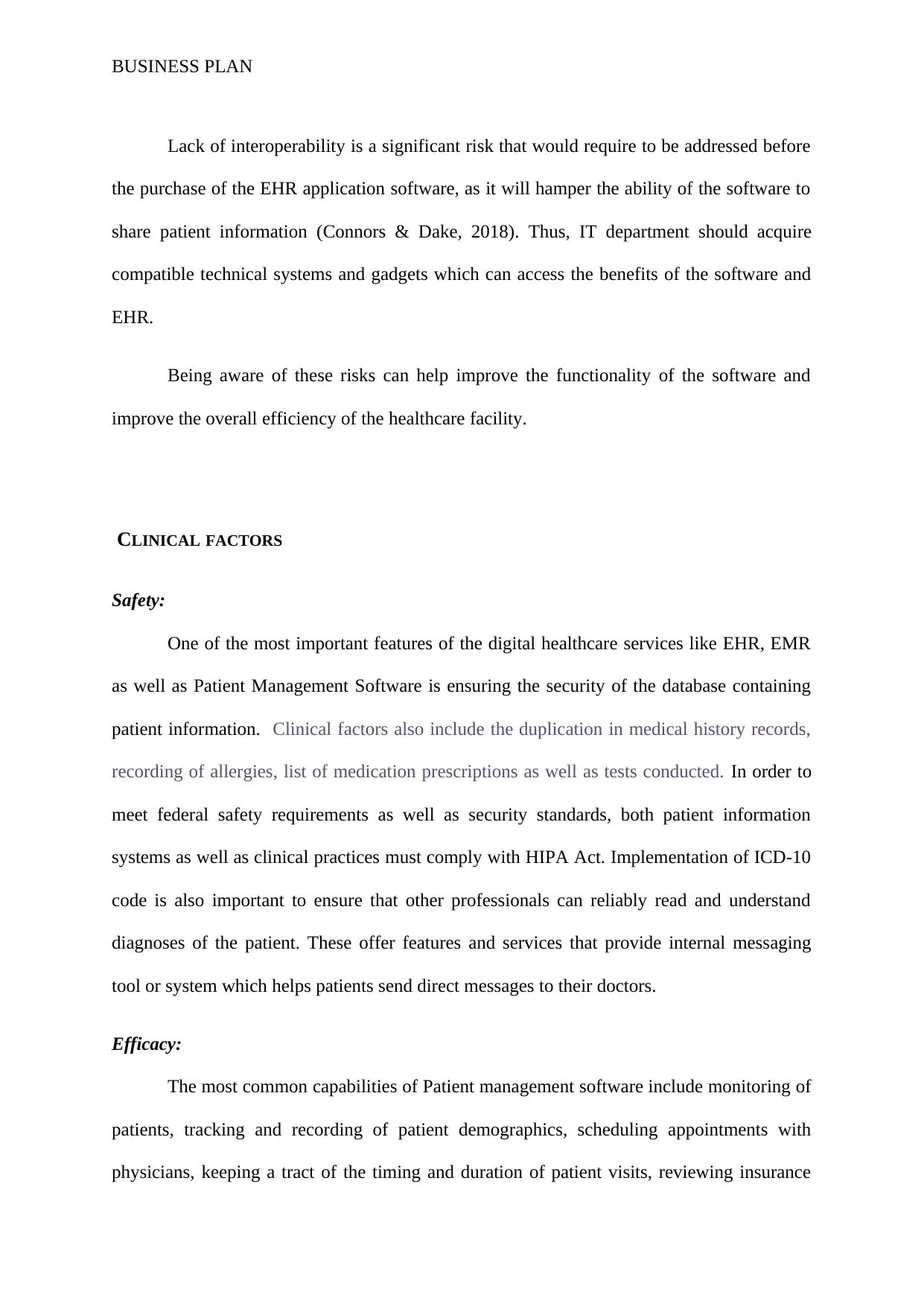
BUSINESS PLAN
Lack of interoperability is a significant risk that would require to be addressed before
the purchase of the EHR application software, as it will hamper the ability of the software to
share patient information (Connors & Dake, 2018). Thus, IT department should acquire
compatible technical systems and gadgets which can access the benefits of the software and
EHR.
Being aware of these risks can help improve the functionality of the software and
improve the overall efficiency of the healthcare facility.
CLINICAL FACTORS
Safety:
One of the most important features of the digital healthcare services like EHR, EMR
as well as Patient Management Software is ensuring the security of the database containing
patient information. Clinical factors also include the duplication in medical history records,
recording of allergies, list of medication prescriptions as well as tests conducted. In order to
meet federal safety requirements as well as security standards, both patient information
systems as well as clinical practices must comply with HIPA Act. Implementation of ICD-10
code is also important to ensure that other professionals can reliably read and understand
diagnoses of the patient. These offer features and services that provide internal messaging
tool or system which helps patients send direct messages to their doctors.
Efficacy:
The most common capabilities of Patient management software include monitoring of
patients, tracking and recording of patient demographics, scheduling appointments with
physicians, keeping a tract of the timing and duration of patient visits, reviewing insurance
Lack of interoperability is a significant risk that would require to be addressed before
the purchase of the EHR application software, as it will hamper the ability of the software to
share patient information (Connors & Dake, 2018). Thus, IT department should acquire
compatible technical systems and gadgets which can access the benefits of the software and
EHR.
Being aware of these risks can help improve the functionality of the software and
improve the overall efficiency of the healthcare facility.
CLINICAL FACTORS
Safety:
One of the most important features of the digital healthcare services like EHR, EMR
as well as Patient Management Software is ensuring the security of the database containing
patient information. Clinical factors also include the duplication in medical history records,
recording of allergies, list of medication prescriptions as well as tests conducted. In order to
meet federal safety requirements as well as security standards, both patient information
systems as well as clinical practices must comply with HIPA Act. Implementation of ICD-10
code is also important to ensure that other professionals can reliably read and understand
diagnoses of the patient. These offer features and services that provide internal messaging
tool or system which helps patients send direct messages to their doctors.
Efficacy:
The most common capabilities of Patient management software include monitoring of
patients, tracking and recording of patient demographics, scheduling appointments with
physicians, keeping a tract of the timing and duration of patient visits, reviewing insurance
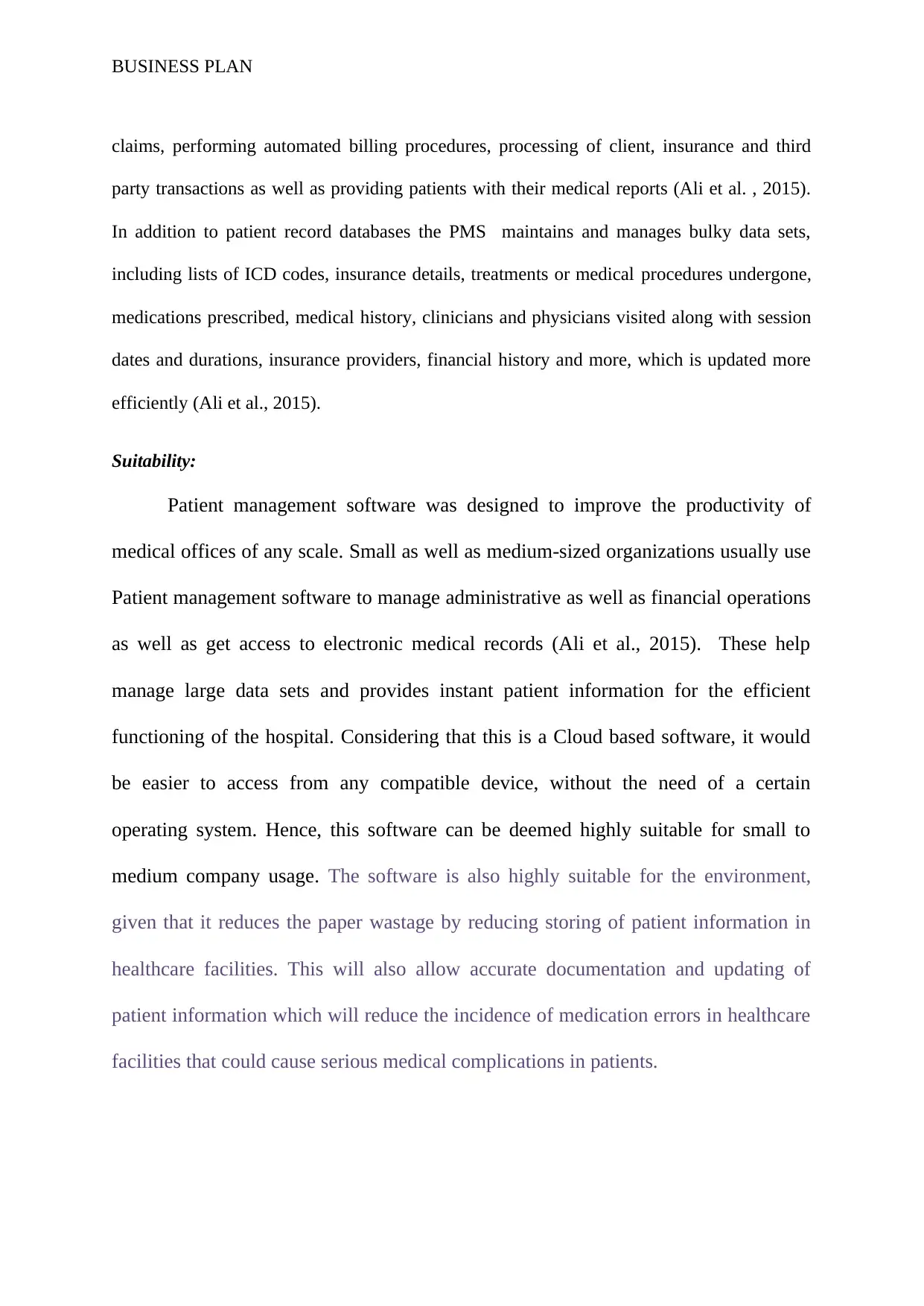
BUSINESS PLAN
claims, performing automated billing procedures, processing of client, insurance and third
party transactions as well as providing patients with their medical reports (Ali et al. , 2015).
In addition to patient record databases the PMS maintains and manages bulky data sets,
including lists of ICD codes, insurance details, treatments or medical procedures undergone,
medications prescribed, medical history, clinicians and physicians visited along with session
dates and durations, insurance providers, financial history and more, which is updated more
efficiently (Ali et al., 2015).
Suitability:
Patient management software was designed to improve the productivity of
medical offices of any scale. Small as well as medium-sized organizations usually use
Patient management software to manage administrative as well as financial operations
as well as get access to electronic medical records (Ali et al., 2015). These help
manage large data sets and provides instant patient information for the efficient
functioning of the hospital. Considering that this is a Cloud based software, it would
be easier to access from any compatible device, without the need of a certain
operating system. Hence, this software can be deemed highly suitable for small to
medium company usage. The software is also highly suitable for the environment,
given that it reduces the paper wastage by reducing storing of patient information in
healthcare facilities. This will also allow accurate documentation and updating of
patient information which will reduce the incidence of medication errors in healthcare
facilities that could cause serious medical complications in patients.
claims, performing automated billing procedures, processing of client, insurance and third
party transactions as well as providing patients with their medical reports (Ali et al. , 2015).
In addition to patient record databases the PMS maintains and manages bulky data sets,
including lists of ICD codes, insurance details, treatments or medical procedures undergone,
medications prescribed, medical history, clinicians and physicians visited along with session
dates and durations, insurance providers, financial history and more, which is updated more
efficiently (Ali et al., 2015).
Suitability:
Patient management software was designed to improve the productivity of
medical offices of any scale. Small as well as medium-sized organizations usually use
Patient management software to manage administrative as well as financial operations
as well as get access to electronic medical records (Ali et al., 2015). These help
manage large data sets and provides instant patient information for the efficient
functioning of the hospital. Considering that this is a Cloud based software, it would
be easier to access from any compatible device, without the need of a certain
operating system. Hence, this software can be deemed highly suitable for small to
medium company usage. The software is also highly suitable for the environment,
given that it reduces the paper wastage by reducing storing of patient information in
healthcare facilities. This will also allow accurate documentation and updating of
patient information which will reduce the incidence of medication errors in healthcare
facilities that could cause serious medical complications in patients.
⊘ This is a preview!⊘
Do you want full access?
Subscribe today to unlock all pages.

Trusted by 1+ million students worldwide
1 out of 29
Related Documents
Your All-in-One AI-Powered Toolkit for Academic Success.
+13062052269
info@desklib.com
Available 24*7 on WhatsApp / Email
![[object Object]](/_next/static/media/star-bottom.7253800d.svg)
Unlock your academic potential
Copyright © 2020–2025 A2Z Services. All Rights Reserved. Developed and managed by ZUCOL.





